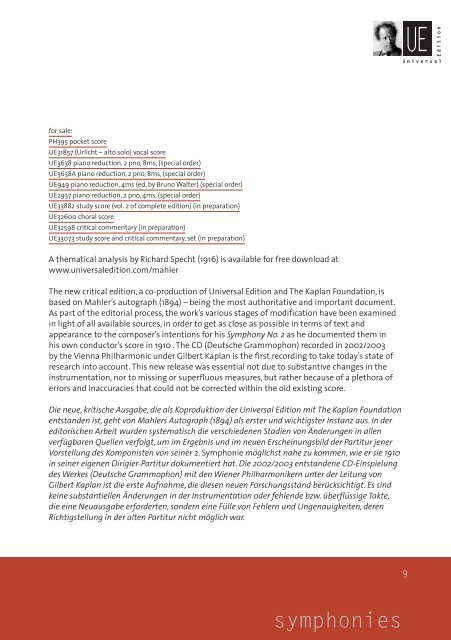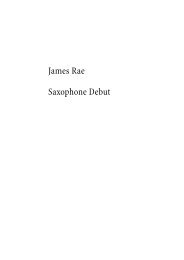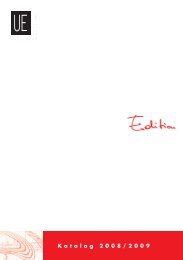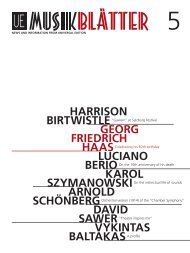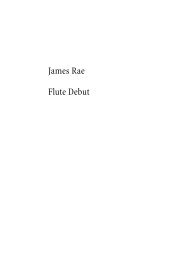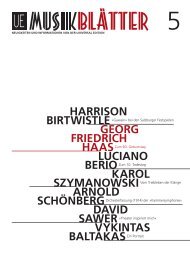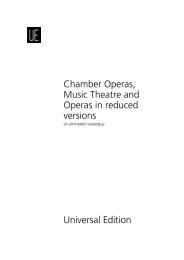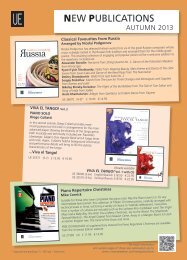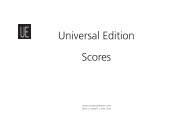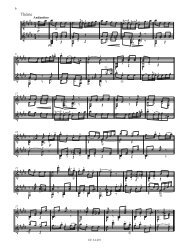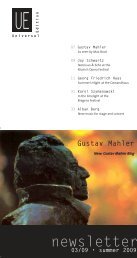Mahler_Catalogue - Universal Edition
Mahler_Catalogue - Universal Edition
Mahler_Catalogue - Universal Edition
Erfolgreiche ePaper selbst erstellen
Machen Sie aus Ihren PDF Publikationen ein blätterbares Flipbook mit unserer einzigartigen Google optimierten e-Paper Software.
for sale:<br />
PH395 pocket score<br />
UE31857 (Urlicht – alto solo) vocal score<br />
UE3638 piano reduction, 2 pno, 8ms, (special order)<br />
UE3638A piano reduction, 2 pno, 8ms, (special order)<br />
UE949 piano reduction, 4ms (ed. by Bruno Walter) (special order)<br />
UE2937 piano reduction, 2 pno, 4ms, (special order)<br />
UE33882 study score (vol. 2 of complete edition) (in preparation)<br />
UE32600 choral score<br />
UE32598 critical commentary (in preparation)<br />
UE33073 study score and critical commentary, set (in preparation)<br />
A thematical analysis by Richard Specht (1916) is available for free download at<br />
www.universaledition.com/mahler<br />
The new critical edition, a co-production of <strong>Universal</strong> <strong>Edition</strong> and The Kaplan Foundation, is<br />
based on <strong>Mahler</strong>’s autograph (1894) – being the most authoritative and important document.<br />
As part of the editorial process, the work’s various stages of modification have been examined<br />
in light of all available sources, in order to get as close as possible in terms of text and<br />
appearance to the composer’s intentions for his Symphony No. 2 as he documented them in<br />
his own conductor’s score in 1910 . The CD (Deutsche Grammophon) recorded in 2002/2003<br />
by the Vienna Philharmonic under Gilbert Kaplan is the first recording to take today’s state of<br />
research into account. This new release was essential not due to substantive changes in the<br />
instrumentation, nor to missing or superfluous measures, but rather because of a plethora of<br />
errors and inaccuracies that could not be corrected within the old existing score.<br />
Die neue, kritische Ausgabe, die als Koproduktion der <strong>Universal</strong> <strong>Edition</strong> mit The Kaplan Foundation<br />
entstanden ist, geht von <strong>Mahler</strong>s Autograph (1894) als erster und wichtigster Instanz aus. In der<br />
editorischen Arbeit wurden systematisch die verschiedenen Stadien von Änderungen in allen<br />
verfügbaren Quellen verfolgt, um im Ergebnis und im neuen Erscheinungsbild der Partitur jener<br />
Vorstellung des Komponisten von seiner 2. Symphonie möglichst nahe zu kommen, wie er sie 1910<br />
in seiner eigenen Dirigier-Partitur dokumentiert hat. Die 2002/2003 entstandene CD-Einspielung<br />
des Werkes (Deutsche Grammophon) mit den Wiener Philharmonikern unter der Leitung von<br />
Gilbert Kaplan ist die erste Aufnahme, die diesen neuen Forschungsstand berücksichtigt. Es sind<br />
keine substantiellen Änderungen in der Instrumentation oder fehlende bzw. überflüssige Takte,<br />
die eine Neuausgabe erforderten, sondern eine Fülle von Fehlern und Ungenauigkeiten, deren<br />
Richtigstellung in der alten Partitur nicht möglich war.<br />
symphonies


